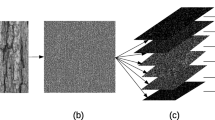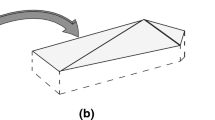Abstract
Texture images are those where the focus of the analysis is on the spatial arrangement of pixels (primitives or textons) rather than on particular objects in the scene. The recognition of such images is naturally challenging as those primitives can be perceived in different manners depending on the image context. Despite the recent success of convolutional neural networks in texture recognition, model-based descriptors are still competitive, especially when we do not have access to large amounts of annotated data for training and the interpretation of the model is an important issue. Among the model-based approaches, fractal geometry has been one of the most popular, especially in biological applications. Nevertheless, fractals are part of a much broader family of models, which are the non-linear operators, studied in chaos theory. This scenario raises the question whether techniques from the broader area of chaos theory could be useful in texture modeling. Those techniques have been used for a long time in image cryptography, but studies on modeling in a broad sense have been scarce in the literature. In this context, we propose here a chaos-based local descriptor for texture recognition. More specifically, we map the image into the three-dimensional Euclidean space, iterate a chaotic map over this three-dimensional structure and convert it back to the original image. From such chaos-transformed image at each iteration we collect local descriptors (here we use local binary patters) and those descriptors compose the feature representation of the texture. The performance of our method was verified on the classification of benchmark databases and in the identification of Brazilian plant species based on the texture of the leaf surface. The achieved results confirmed our expectation of a competitive performance, even when compared with some learning-based modern approaches in the literature.





Similar content being viewed by others
Notes
Here we adopt the convention of setting the first index of a vector/matrix as 1, which is more consistent with mathematical notation and independent of programming language.
References
Al-Shemarry MS, Li Y, Abdulla S (2020) An efficient texture descriptor for the detection of license plates from vehicle images in difficult conditions. IEEE Trans Intell Transp Syst 21(2):553–564
Awad AI, Hassaballah M (2016) Image feature detectors and descriptors; foundations and applications, vol 630. Springer International Publishing, New York
Bishop CM (2006) Pattern recognition and machine learning (information science and statistics). Springer, Berlin, Heidelberg
Bruna J, Mallat S (2013) Invariant scattering convolution networks. IEEE Trans Pattern Anal Mach Intell 35(8):1872–1886
Casanova D, de Mesquita Sá Junior JJ, Bruno OM (2009) Plant leaf identification using gabor wavelets. Int J Imaging Syst Technol 19 (3):236–243
Chan T, Jia K, Gao S, Lu J, Zeng Z, Ma Y (2015) PCANet: A simple deep learning baseline for image classification? IEEE Trans Image Process 24(12):5017–5032
Chandramouli K, Izquierdo E (2006) Image classification using chaotic particle swarm optimization. 2006 International Conference on Image Processing, pp 3001–3004
Chen G, Mao Y, Chui CK (2004) A symmetric image encryption scheme based on 3D chaotic cat maps. Chaos, Solitons & Fractals 21(3):749–761
Cimpoi M, Maji S, Kokkinos I, Mohamed S, Vedaldi A (2014) Describing textures in the wild. In: Proceedings of the 2014 IEEE conference on computer vision and pattern recognition, IEEE Computer Society, Washington, DC, USA, CVPR ’14, pp 3606–3613
Cimpoi M, Maji S, Kokkinos I, Vedaldi A (2016) Deep filter banks for texture recognition, description, and segmentation. Int J Comput Vis 118 (1):65–94
Cortes C, Vapnik V (1995) Support-vector networks. Mach Learn 20(3):273–297
Dai X, Ng JY, Davis LS (2017) Fason: First and second order information fusion network for texture recognition. In: 2017 IEEE conference on computer vision and pattern recognition (CVPR), pp 6100–6108. https://doi.org/10.1109/CVPR.2017.646
Donahue J, Jia Y, Vinyals O, Hoffman J, Zhang N, Tzeng E, Darrell T (2014) Decaf: A deep convolutional activation feature for generic visual recognition. In: Proceedings of the 31st international conference on international conference on machine learning. JMLR.org, ICML’14, vol 32, pp I–647–I–655
Florindo JB, Bruno OM (2011) Fractal descriptors in the Fourier domain applied to color texture analysis. Chaos 21(4)
Florindo JB, Bruno OM (2017) Discrete schroedinger transform for texture recognition. Inform Sci 415:142–155
Florindo JB, Casanova D, Bruno OM (2018) A Gaussian pyramid approach to Bouligand–Minkowski fractal descriptors. Inform Sci 459:36–52
Gleick J (1987) Chaos: Making a New Science. Penguin Books, USA
Gonçalves WN, da Silva NR, da Fontoura Costa L, Bruno OM (2016) Texture recognition based on diffusion in networks. Inform Sci 364(C):51–71
Goodfellow I, Bengio Y, Courville A (2016) Deep Learning. MIT Press, Cambridge. http://www.deeplearningbook.org
Guo Y, Wu Y, Ju Z, Wang J, Zhao L (2010a) Remote sensing image classification by the chaos genetic algorithm in monitoring land use changes. Math Comput Model 51:1408–1416
Guo Z, Zhang L, Zhang D (2010b) A completed modeling of local binary pattern operator for texture classification. Trans Img Proc 19(6):1657–1663
Guo Z, Zhang L, Zhang D (2010c) Rotation invariant texture classification using lbp variance (lbpv) with global matching. Pattern Recogn 43(3):706–719
Haralick R, Shanmugam K, Dinstein I (1973) Texture features for image classification. IEEE Trans Systems Man Cybern 3(6)
Hassaballah M, Awad AI (2016) Detection and description of image features. An Introduct 630:1–8
Hayman E, Caputo B, Fritz M, Eklundh JO (2004) On the significance of real-world conditions for material classification. In: Pajdla T, Matas J (eds) Computer Vision - ECCV 2004. Springer, Berlin, pp 253–266
Ho TK (1995) Random decision forests. In: Proceedings of the third international conference on document analysis and recognition (Volume 1). ICDAR ’95, vol 1. IEEE Computer Society, Washington, p 278
Jakimoski G, Kocarev L (2001) Chaos and cryptography: Block encryption ciphers based on chaotic maps. IEEE Trans Circ Syst I-Regul Papers 48 (2):163–169
Julesz B (1981) Textons, the elements of texture perception, and their interactions. Nature 290(5802):91–97
Kannala J, Rahtu E (2012) Bsif: Binarized statistical image features. In: ICPR IEEE Computer Society, pp 1363–1366
Ke Q, Oommen BJ (2014) Logistic neural networks: Their chaotic and pattern recognition properties. Neurocomputing 125:184–194
Lan R, Zhong S, Liu Z, Shi Z, Luo X (2018) A simple texture feature for retrieval of medical images. Multimed Tools Appl 77(9):10853–10866. https://doi.org/10.1007/s11042-017-5341-2
Lazebnik S, Schmid C, Ponce J (2005) A sparse texture representation using local affine regions. IEEE Trans Pattern Anal Mach Intell 27(8):1265–1278
Leguizamón S, Espínola M, Ayala R, Iribarne L, Menenti M, Ordonez de Pablos P, Ziderman A, Roulstone A, Maurer H, Imber JB (2010) Characterization of texture in images by using a cellular automata approach. In: Lytras MD (ed) Organizational, business, and technological aspects of the knowledge society. Springer, Berlin, pp 522–533
Liu L, Fieguth P, Kuang G (2011) Compressed sensing for robust texture classification. In: Kimmel R, Klette R, Sugimoto A (eds) Computer Vision – ACCV 2010. Springer, Berlin, pp 383–396
Lowe DG (2004) Distinctive image features from scale-invariant keypoints. Int J Comput Vis 60(2):91–110
Maritz MF (2020) A note on exact solutions of the logistic map. Chaos: Interdiscipl J Nonlinear Sci 30(3):033136
McLachlan GJ (2004) Discriminant analysis and statistical pattern recognition. N.J, Wiley-Interscience Hoboken
Nathan D, Aitken A, Holden EJ, Wong J (2020) Imaging sedimentary basins from high-resolution aeromagnetics and texture analysis. Comput Geosci 136
Ojala T, Pietikäinen M, Mäenpää T (2002) Multiresolution gray-scale and rotation invariant texture classification with local binary patterns. IEEE Trans Pattern Anal Mach Intell 24(7):971–987
Perronnin F, Sánchez J, Mensink T (2010) Improving the fisher kernel for large-scale image classification. In: Proceedings of the 11th european conference on computer vision: Part IV. ECCV’10. Springer, Berlin, pp 143–156
Quan Y, Xu Y, Sun Y, Luo Y (2014) Lacunarity analysis on image patterns for texture classification. In: 2014 IEEE Conference on Computer Vision and Pattern Recognition, pp 160–167
da Silva NR, der Weeën PV, Baets BD, Bruno OM (2015) Improved texture image classification through the use of a corrosion-inspired cellular automaton. Neurocomputing 149:1560–1572
Song T, Li H, Meng F, Wu Q, Cai J (2018) LETRIST: Locally Encoded Transform Feature Histogram for Rotation-Invariant Texture Classification. IEEE Trans Circ Syst Video Technol 28(7):1565–1579
Song Y, Zhang F, Li Q, Huang H, O’Donnell LJ, Cai W (2017) Locally-transferred fisher vectors for texture classification. In: 2017 IEEE international conference on computer vision (ICCV), pp 4922–4930. https://doi.org/10.1109/ICCV.2017.526
Taraschi G, Florindo JB (2020) Computing fractal descriptors of texture images using sliding boxes: An application to the identification of brazilian plant species. Physica A: Stat Mechan Appl 545:123651
Timofte R, Gool LV (2012) A training-free classification framework for textures, writers, and materials. BMVC
Varma M, Zisserman A (2005) A statistical approach to texture classification from single images. Int J Comput Vis 62(1):61–81
Varma M, Zisserman A (2009) A statistical approach to material classification using image patch exemplars. IEEE Trans Pattern Anal Mach Intell 31 (11):2032–2047
Xu Y, Huang SB, Ji H, Fermüller C (2009a) Combining powerful local and global statistics for texture description. In: IEEE Conference on Computer Vision and Pattern Recognition, 2009. CVPR 2009, IEEE. IEEE, pp 573–580
Xu Y, Ji H, Fermüller C (2009b) Viewpoint invariant texture description using fractal analysis. Int J Comput Vis 83(1):85–100
Xue J, Zhang H, Dana K (2018) Deep texture manifold for ground terrain recognition. Proceedings of the IEEE Conference on Computer Vision and Pattern Recognition (CVPR)
Yin B, Wang C, Abza F (2020) New brain tumor classification method based on an improved version of whale optimization algorithm. Biomed Signal Process Control 56:101728
Yu W, Wang D (2015) Image chaotic characteristics and application in face recognition. J Comput-Aided Design Comput Graph 27:2264–2271
Yu WB (2017) Application of chaos in image processing and recognition. In: 2017 international conference on computer systems electronics and control (ICCSEC), pp 1108–1113
Zhai W, Cao Y, Zhang J, Zha ZJ (2019) Deep multiple-attribute-perceived network for real-world texture recognition. In: Proceedings of the IEEE/CVF International Conference on Computer Vision (ICCV)
Zhang H, Xue J, Dana K (2017) Deep ten: Texture encoding network. In: 2017 IEEE conference on computer vision and pattern recognition (CVPR), pp 2896–2905. https://doi.org/10.1109/CVPR.2017.309
Zhao L, Macau EEN (2001) A network of dynamically coupled chaotic maps for scene segmentation. IEEE Trans Neural Netw 12(6):1375–1385
Acknowledgements
This work was supported by the Serrapilheira Institute (grant number Serra-1812-26426). J. B. Florindo also gratefully acknowledges the financial support from National Council for Scientific and Technological Development, Brazil (CNPq) (Grants #301480/2016-8 and #423292/2018-8).
Author information
Authors and Affiliations
Corresponding author
Ethics declarations
Conflict of interests
The authors declare that they have no conflict of interest.
Additional information
Publisher’s note
Springer Nature remains neutral with regard to jurisdictional claims in published maps and institutional affiliations.
Rights and permissions
About this article
Cite this article
Florindo, J.B. Reorganizing local image features with chaotic maps: an application to texture recognition. Multimed Tools Appl 80, 29177–29197 (2021). https://doi.org/10.1007/s11042-021-10959-0
Received:
Revised:
Accepted:
Published:
Issue Date:
DOI: https://doi.org/10.1007/s11042-021-10959-0




